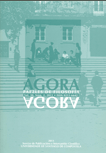PROPUESTA DE APLICACIÓN DE LA METODOLOGÍA DE CRISTIN CHALL PARA LA EVALUACIÓN DE TEORÍAS DEL ESTADO PASADO COSMOLÓGICO
Contenido principal del artículo
Resumen
El punto de partida para este ensayo es responder a la pregunta de por qué el llamado Estado Pasado del Universo es un problema epistémico que vale la pena ser abordado, entre otras razones, porque en caso de no aceptar su validez ello derivaría en una ‘catástrofe escéptica’. Posteriormente, hacemos una revisión de la metodología para evaluación de teorías propuesta por el Dr. Cristin Chall, quien la elaboró a partir de un híbrido entre los programas de investigación científicos (PICs) introducidos por Imré Lakatos, junto con la capacidad de solución de problemas en la racionalidad científica, tomada de la metodología de tradiciones de investigación de Larry Laudan. Una vez revisada la metodología de Chall, nos proponemos aplicarla a dos teorías (la de la inflación y la del Ciclo Cosmológico Conforme) que lidian con el llamado Estado Pasado cosmológico, con el fin de intentar determinar cuál de ellas es epistémicamente más viable. Cabe resaltar que nuestro propósito no es invalidar ninguna de estas teorías, sino más bien llevar a cabo un ejercicio de evaluación de virtudes epistémicas desde la filosofía de la ciencia, en este caso enfocada a la cosmología.
Palabras clave:
Detalles del artículo
Referencias
Albert, David (2003). Time and Chance, Cambridge, Mass.: Harvard University Press.
Albrecht, Andreas; Steinhardt, Paul J. (1982). "Cosmology for Grand Unified Theories with Radiatively Induced Symmetry Breaking", Physical Review Letters, 48 (17): 1220-1223.
Baras, Dan; Shenker, Orly (2020). “Calling for explanation: the case of the thermodynamic past state”, European Journal for Philosophy of Science, 36 https://doi.org/10.1007/s13194-020-00297-7
Callender, Craig (2021). “Thermodynamic Asymmetry in Time” The Stanford Encyclopedia of Philosophy (Fall 2024 Edition), Edward N. Zalta & Uri Nodelman (eds.), URL = <https://plato.stanford.edu/archives/fall2024/entries/time-thermo/>;
Carroll, Sean (2010). From eternity to here, New York: Dutton Penguin Publishing Group.
Cartlidge, Edwin (2010). “Penrose claims to have glimpsed universe before Big Bang” en physicsworld.com, nov. 2010.
Chall, Cristin (2019). Non-Empirical Modelling and Theorizing: Scientific Progress in Particle Physics, Tesis doctoral de Filosofía, Universidad de Carolina del Sur.
Chall, Cristin (2020). “Model-groups as scientific research programmes”, European Journal for Philosophy of Science 10 (1): 1-24, https://link.springer.com/article/10.1007/s13194-019-0271-7
De Abreu, Adam et al. (2015). “Searching for concentric low variance circles in the cosmic microwave background”, Journal of Cosmology and Astroparticle Physics. (12), arXiv:1508.05158
Di Bari, Pasquale (2018). Cosmology and the early Universe, Boca Raton: CRC Press.
Guth, Alan H. (1990). Observational Tests of Cosmological Inflation, Dordrecht,.NL: Kluwer Academic Publishers, Dordrecht, NL.
Guth, Alan H. (1997). The inflationary Universe, Massachusetts: Addison-Wesley.
Guth, Alan; Penrose, Roger (2021). “Multiverse or Cyclic Universe ? Alan Guth vs Roger Penrose”, (agosto 2021), https://www.youtube.com/watch?v=YhbULagUKhA&t=38s
Hooton, Christopher (2014). “Big Bang research blunder leaves multiverse theory in ruins,
theoretical physicist claims”: Independent. En
Iljas, Anna; Steinhardt, Paul J. (2017). “POP goes the Universe”, Scientific American, 316: 32-39.
Lakatos, Imré (1970). “Falsification and the methodology of scientific research programmes”, en: Lakatos, I. and Musgrave, A. (Eds.), Criticism and the Growth of Knowledge, Cambridge: Cambridge University Press.
Lakatos, Imré (1978). “History of science and its rational reconstructions”, en Currie, G., & Worrall, J. (Eds.), The methodology of scientific research programmes: philosophical papers, Vol. 1, New York: Cambridge University Press.
Laudan, Larry (1977). Progress and its Problems, Berkeley and Los Angeles: University of California Press.
Linde, Andrei (1994). “The Self-Reproducing Inflationary Universe”, Scientific American, november 1994.
Patel, Vihan y Lineweaver, Charles (2017). “Solutions to the Cosmic Initial Entropy Problem without Equilibrium Initial Conditions”, Entropy, 19 (8), 411; doi:10.3390/e19080411.
Penrose, Roger (1999). The Emperor’s New Mind, New York: Oxford University Press.
Penrose, Roger (2010). Cycles of Time, London: The Bodley Head Edit.
Penrose, Roger; Gurzadyan, VG, (2010). “Concentric circles in WMAP data may provide evidence of violent pre-Big-Bang activity”. arXiv, arXiv:1011.3706 [astro-ph.CO], noviembre 2010.
Price, Huw (2004). “On the origins of the arrow of time: why there is still a puzzle about the Low-Entropy Past”, en Hitchcok, C, (ed.) Contemporary debates in the Philosophy of Science, Oxford: Blackwell Publishing, pp. 219-234.
Steinhardt, Paul J. (2011). “The inflation debate”, Scientific American, abril 2011.
Takahashi, Yuki (2003). Cosmic microwave background polarization: The next key toward the origin of the Universe, archivado en https://web.archive.org/web/20171117132614/http://cosmology.berkeley.edu/~yuki/CMBpol/CMBpol.htm
Wallace, David (2011). “The logic of the past hypothesis”, University of Pittsburgh, https://philsci-archive.pitt.edu/8894/1/pastlogic_2011.pdf
Zaldarriaga, Matias; Seljak, Uros (1998) “Gravitational lensing effect on cosmic microwave background polarization”, Physical Review D. 58 2, julio 1998. https://doi.org/10.48550/arXiv.astro-ph/9803150







